Colour Constancy for Visual Surveillance
Aim
A Visual Surveillance system is expected to be operated 24/7, therefore
it is inevitable that the illumination of the scene will vary
significantly, especially in outdoor environments. A real-time
automatic algorithm that can ensure that colour responses are failly
constant is required to allow the system to respond reliably to
colour-based queries.
The objective of colour constancy is to re-create the scene as it would
appear under some known illuminant source (see below)
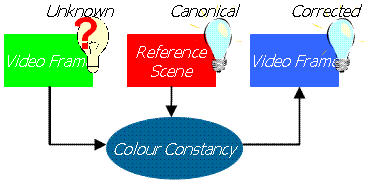
Colour Variation
Shots of an outdoor scene were captured with rate 1 frame/minute for 20
days.
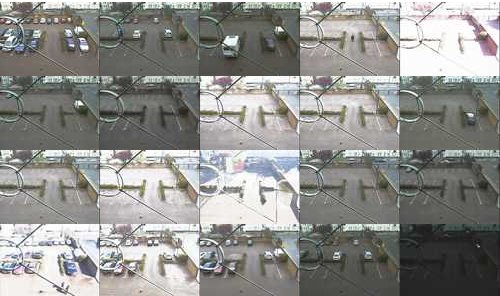
To estimate the level of colour variation, we accumulated the colour
responses of five pre-defined patches on the image.
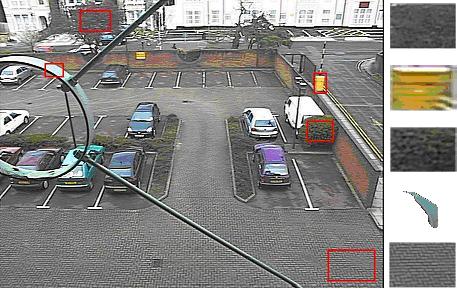
The following graph shows the colour responses (Hue, Saturation) for
each patch over the observation time period (each colour represents a
single patch). The variation of the responses is significant,
especially for surfaces of high reflectance. (such as the yellow box at
the left or the green metal surface at the right). Therefore, a colour
constancy algorithm is necessary to ensure a common colour reference
system for long observation periods.
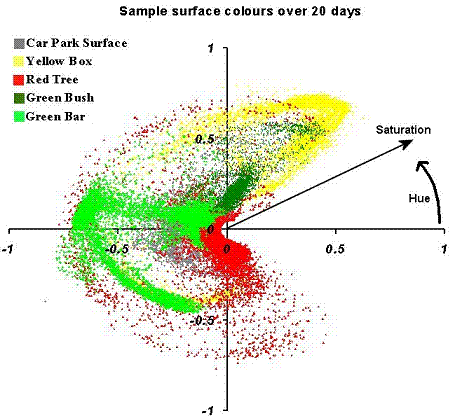
Colour Constancy Algorithms
We experimented with two well-known algorithms: The Grey World
algorithm and the Gamut Mapping
The Grey World algorithm is based on the assumption that the average of
spatial reflectances in a scene is achromatic and is applied by a
linear transformation.
The Gamut Mapping method attempts to fit a gamut of colour responses of
the current frame to the gamut of reference frame.
Automatic Reference Frame Selection
To allow easy initialisation of the system, a method that automatically
selects Reference Frame from a video stream was developed. In the HSL
colour system, the frame
with the highest average of projected saturation magnitude (S) on the
plane L=0.5 over all the pixels
is selected.
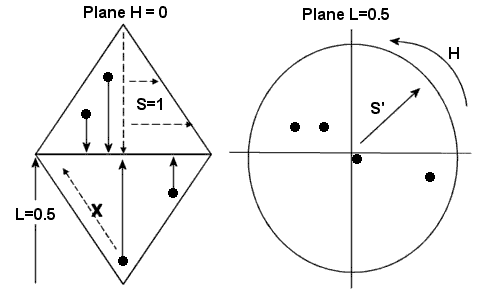
This criterion penalises the chromatic features at either
end of the intensity dimension, which can exhibit a high saturation,
but relatively little colour information. The selected reference frame
is expected to have rich colours.
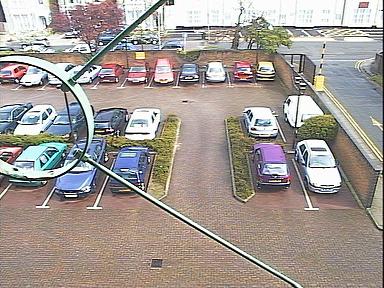
Conclusion
According to our evaluation, the Gamut Mapping outperforms the Grey
World algorithm. However, the former can be very slow and inappropriate
for online processing. Therefore, the Grey World algorithm is suggested
for real time applications that quality
is not crucial. If quality is
the priority, then the Gamup mapping should be used.
Publications
J.R. Renno, D. Makris, T.J. Ellis, G.A. Jones, "Application
and Evaluation of Colour Constancy in Visual Surveillance", Joint
IEEE International Workshop on Visual Surveillance and Performance
Evaluation (VS-PETS 2005), Beijing, China, (2005) abstract download
About this work
This work is part of the EPSRC-funded project REVEAL,
conducted by John-Paul
Renno, Dimitrios
Makris, Tim
Ellis and Graeme
Jones.
